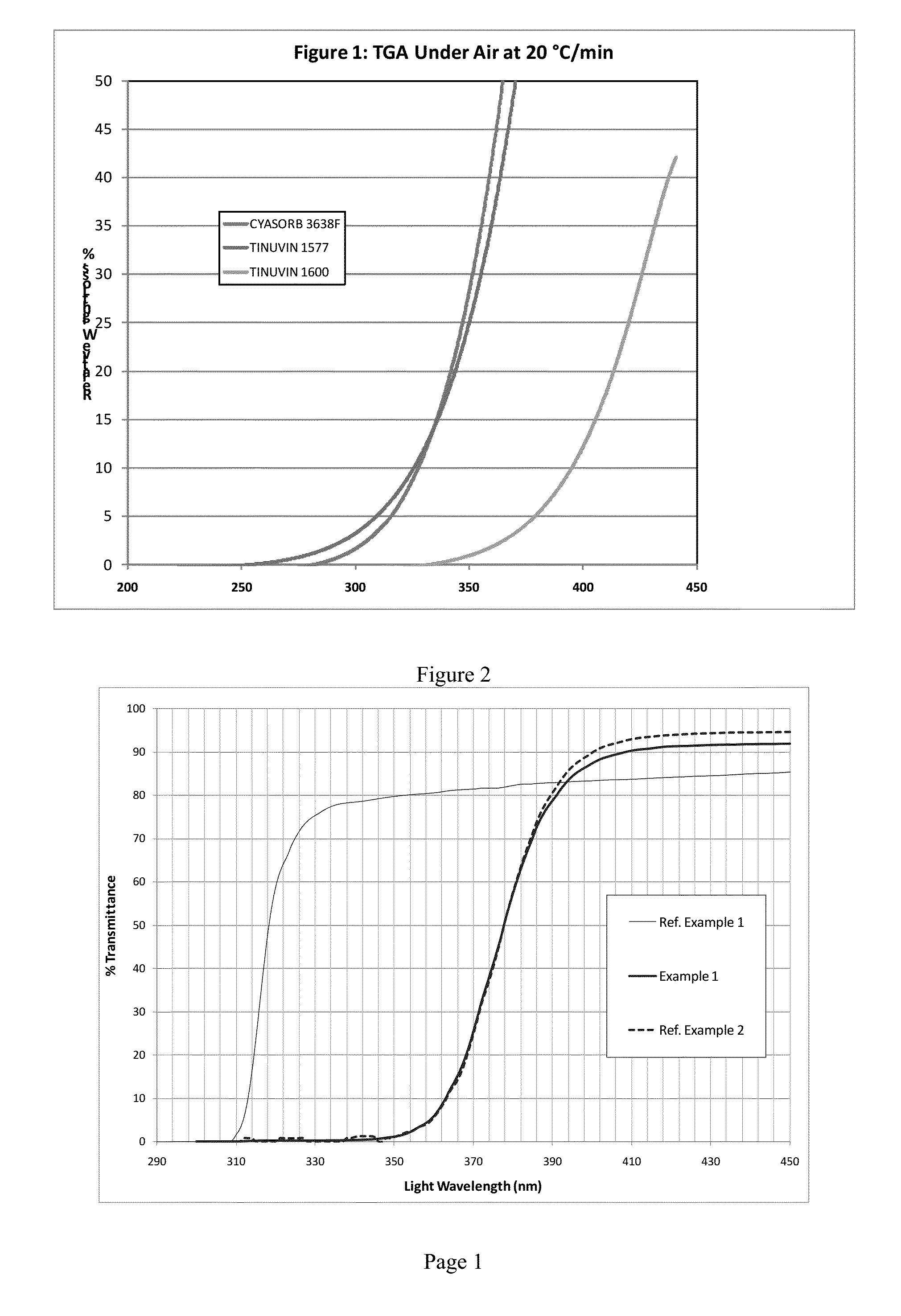Addition of non-reactive UV absorbers during polyester synthesis
a technology of non-reactive uv absorbers and polyester, which is applied in the direction of organic dyes, etc., can solve the problems of prolonging the life of fixtures and fittings, not being suitable for film production, and being susceptible to damage by energy absorbed, etc., and achieves the effects of improving stability, improving uniformity, and being more economical
- Summary
- Abstract
- Description
- Claims
- Application Information
AI Technical Summary
Benefits of technology
Problems solved by technology
Method used
Image
Examples
example 1
In-Situ Reactor Incorporation of Tinuvin 1600
[0072]A 10-liter stainless steel reactor, equipped with heating mantle, stirrer, addition ports, and overhead distillation column was charged with 1741 grams of ethyleneglycol and 3952 grams of purified terephthalic acid. The reactor was purged with nitrogen to 40 psig and heated at a heater temperature setting of 275° C., while stirring at 55 RPM. During the course of the esterification a back pressure regulator maintained the reactor pressure to 55 psia by letting the gas overhead escape to the overhead distillation column; this resulted in collection of water esterification byproduct from the top of the column and refluxing of the ehthyleneglycol vapors back to the reactor. The temperature at the top of the distillation column stayed at 140° C. (temperature of saturated steam at 55 psia) during the course of the esterification. After 320 min into the reaction, the temperature at the top of the column started dropping, indicating that n...
example 2
In-Situ Reactor Incorporation of Tinuvin 1577
[0083]The polymerization described in example 1 was repeated, however this time the UV absorber incorporated in situ in the form of 20% slurry in ethyleneglycol to a concentration of 1 wt. % based on final polymer weight was Tinuvin 1577. The results of the chip analysis and polymerization time to reach target IV are shown on Table 1.
[0084]Clear film was cast by melt extrusion from the resulting chip and tested as described in Example 1. The film properties are shown on Table 2.
reference example 1
[0085]The polymerization described in example 1 was repeated; however no UV absorber was incorporated. The results of the chip analysis and polymerization time to reach target IV are shown on Table 1.
[0086]Clear film was cast by melt extrusion from the resulting chip and tested as described in Example 1. The film properties are shown on Table 3.
TABLE 1
The measured In-Situ incorporation level of Tinuvin 1600 (essentially 100%) and Tinuvin 1577 (90%) is consistent with their volatility measured by TGA.
PUM
| Property | Measurement | Unit |
|---|---|---|
| temperature | aaaaa | aaaaa |
| wavelengths | aaaaa | aaaaa |
| wavelengths | aaaaa | aaaaa |
Abstract
Description
Claims
Application Information
 Login to View More
Login to View More - R&D
- Intellectual Property
- Life Sciences
- Materials
- Tech Scout
- Unparalleled Data Quality
- Higher Quality Content
- 60% Fewer Hallucinations
Browse by: Latest US Patents, China's latest patents, Technical Efficacy Thesaurus, Application Domain, Technology Topic, Popular Technical Reports.
© 2025 PatSnap. All rights reserved.Legal|Privacy policy|Modern Slavery Act Transparency Statement|Sitemap|About US| Contact US: help@patsnap.com



